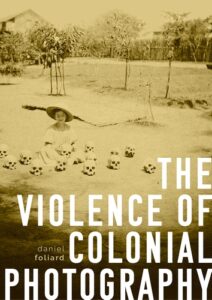
The violence of colonial photography
Publication | Table des matières | Critiques
Résumé
The late nineteenth century saw a rapid increase in colonial conflicts throughout the French and British empires. It was also the period in which the camera began to be widely available. Colonial authorities were quick to recognise the power of this new technology, which they used to humiliate defeated opponents and to project an image of supremacy across the world.
Drawing on a wealth of visual materials, from soldiers’ personal albums to the collections of press agencies and government archives, this book offers a new account of how conflict photography developed in the decades leading up to the First World War. It explores the various ways in which the camera was used to impose order on subject populations in Africa and Asia and to generate propaganda for the public in Europe, where a visual economy of violence was rapidly taking shape. At the same time, it reveals how photographs could escape the intentions of their creators, offering a means for colonial subjects to push back against oppression.
Table des matières
- Foreword by Kim A. Wagner
- Introduction
- 1 Repulsion, erasure, and loss of contrast
- 2 Photography as power: force and counterforce
- 3 Depths of field: darkrooms and conflicts prior to the 1890s
- 4 Conflicts in the lens: from the 1890s to the First World War
- 5 The public and the private: regimes of visibility
- 6 Subversion, denunciation, and manipulation
- 7 The enemy’s body
- 8 Paper cemeteries
- 9 Invisible wars? Reflections of extra-European conflicts in France and
- Britain
- Conclusion: ceci n’est pas une illustration
- Index
Critiques
‘The violence of colonial photography is a compelling account of photography as an instrument of British and French imperialisms. Mining a wide range of archival images from the late nineteenth and early twentieth centuries, Daniel Foliard offers a rich, albeit disturbing, history of how the production, dissemination and circulation of photographic depictions of symbolic and literal violence enabled and justified colonial power.’
Professor Ali Behdad, author of Camera Orientalis: Reflections on Photography of the Middle East
‘The photographic archives of colonial expansion and the tainted ways of looking they have engendered have never been read with such thoughtful sensitivity, compassion and insight as in this book. Foliard powerfully exposes the imbrication of the camera in colonial violence even as he enjoins us to attend with care to the brutalised bodies and, as much as possible, to the people whose images confront us in this chilling and illuminating book.’
Professor Marianne Hirsch, co-author of School Photos in Liquid Time: Reframing Difference
Praise for the French edition
‘In this brilliant study, Daniel Foliard delivers a subtle history of violence and its representations. Steamships, quinine, the machinegun: to these instruments of western colonial conquest at the end of the nineteenth-century we must now add the camera. Such is the lesson of Combat, punish, photograph, which is dedicated to images of violence from the pre-1914 imperial world . After closing this powerful and demanding book, you’ll never look at photos of violence, whether historical or contemporary, in the same way again.’ (French edition)
André Loez, Le Monde
‘Drawing on fascinating research in the British and French archives, [the author] recounts the creation of war photography in a colonial context. With great precision, he shows how the expeditions of the years 1890 to 1914 – the inaptly named “little wars” – radically transformed the representation of the suffering of others . Far from being sensationalist, the book, which appears in the new series “Histoire-monde” from Editions La Découverte, is a rigorous demonstration of the combined power of Kodak and empire.’ (French edition)
Sylvain Venayre, L’Histoire
‘…in its exceptional scope, nuance and sophisticated linking of histories of photography and violence, this book is a landmark publication in the field and must surely be the go-to for a comprehensive study of early colonial conflict photography.’ (French edition)
Will Fysh, H-France Review
- “This important volume from an authoritative international team of authors sheds significant new light on the comparative development of post-war Conservatism in the western world.”
– Stuart Ball, Professor Emeritus, University of Leicester, UK - “The rich essays collected in this illuminating volume show that the rise of right-wing politics in the United Kingdom, the United States, and France since the 1970s was a remarkably transnational phenomenon. As they attacked social democracy and cultural pluralism, right-wing movements borrowed ideas, visions, vocabularies, and tactics from each other, adapting them to their own national idioms and using advances in one country to win advances elsewhere. Anyone interested in confronting the problems that have proliferated in the wake the right’s reconfiguration of politics – surging inequality, belligerent ethno-nationalism, worker disempowerment and insecurity, and lost faith in the capacity for democratic self-government – has much to learn about the origins of these problems from this important book.”
– Joseph A. McCartin, Georgetown University, USA, author of Collision Course
